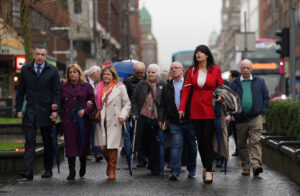Cape Town–based diversity trainer Asanda Ngoasheng is no stranger to invitations for one-off workshops and talks from schools. But in the past few weeks, some schools have for the first time signed long-term contracts with her to implement diversity curricula.
That shift has emerged from an eruption of protests at South Africa’s most elite schools against the racism experienced by Black students, teachers and parents. The entire class of final year high school students at Bishops in Cape Town has submitted a petition calling out “systemic oppression.” Parents at St. Mary’s DSG in Pretoria have gathered at the school, holding placards saying things like “I cannot pay for my child to be oppressed.” And an Instagram account, @yousilenceweamplify, has highlighted nearly 300 heart-wrenching testimonials from Black students across the country.
While individual racist incidents — pertaining to things like hair policies and hate speech — at such elite schools have drawn a backlash in the past, the current wave of protests is unprecedented in its scale and its focus on systems, not individuals. “A racist structure can violate you without a word being said,” says Ngoasheng.
PEOPLE ARE LOOKING AT LONG-TERM SOLUTIONS AS IT’S CLEAR THAT THE PROBLEM WON’T GO AWAY.
ASANDA NGOASHENG, DIVERSITY TRAINER
These protests are also drawing support from large numbers of white students and parents. And while some schools are still employing age-old tactics focused on image management, others — like the schools that have hired Ngoasheng — are attempting to reform.
“Now people are looking at long-term solutions as it’s clear that the problem won’t go away,” says Ngoasheng.
While the international Black Lives Matter movement lit the immediate spark for these protests, they’re the outcome of an education system that has repeatedly had to be challenged. On June 16, 1976, apartheid-era police opened fire on Black students protesting against being taught in Afrikaans, killing at least 176 people. Under apartheid, white schools were deliberately given extra resources while Black schools were underfunded.
Even Black teachers in Blacks-only township schools were required to implement racist policies and deliver inferior education designed to keep non-whites down. The advent of democracy in 1994 might have changed the country’s laws, but it did little to dismantle the structures of educational apartheid or to change the belief among many white people that Blacks didn’t deserve quality education.
In 2015 and 2016, students at universities across South Africa protested under the #RhodesMustFall and #FeesMustFall movements to demand the decolonization of higher education in South Africa and reject tuition fee increases. The current movement takes those movements forward, suggests Ngoasheng. “Many of the inequalities highlighted by #RhodesMustFall and #FeesMustFall start in the schooling system.”

Students attack the defaced statue of British mining magnate and politician Cecil John Rhodes as it is removed from the University of Cape Town on April 9, 2015.
Thanks in no small part to the foundations laid by those earlier movements, schools are taking the protests seriously. Take the online petition to end institutionalized racism at Herschel Girls School in Cape Town, where students say their voices have been silenced when they’ve raised them in the past. Within a few days, the petition drew more than 8,000 signatures. Emmanuelle Tshala, who graduated from the school in 2015, created the petition after seeing Herschel post a black square on social media purportedly in solidarity with the protests over George Floyd’s murder. After checking with current pupils that the systemic racism she had experienced at the school was persisting, she decided to publicly call out their hypocrisy.
The school management acted swiftly, and called Tshala for a meeting. She recalls being “very pleasantly surprised” to see that they had already implemented a transformation plan and hired a transformation officer. They also invited Tshala, who will soon start a postgraduate degree in justice and transformation, to play an ongoing role in transformation at the school. Herschel’s response, she says, has been “not at all defensive” and “a model for other schools.”
Whether other schools eventually follow suit will largely depend, she says, on two factors: the caliber of leadership and the continued exertion of “sustained, external pressure.” The Department of Education — which has previously done little to deal with entrenched racism, partly because the main culprits were top academic schools — is finally stepping in to mediate between schools and aggrieved past and current pupils.
Meaningful change won’t come easily. It’ll need an overhaul of admissions processes, implementation of employment equity, policies to report and track racist incidents, rewritten curricula and the elimination of unconscious biases in teachers, parents and students.
The current protests are restricted to expensive private schools (i.e., the whitest schools in the country) and so-called Model C schools — fee-paying, former-whites-only schools that are partly funded by the government and partly by parents. These schools host only a fraction of South Africa’s student population. But Ngoasheng points out “parents at these schools are leaders in business and society who set the tone for the rest of the country.” Change, she says, will only come “if the elite are forced to understand the importance of racial equality.”
These protests are making sure their demands won’t be easy to ignore.




